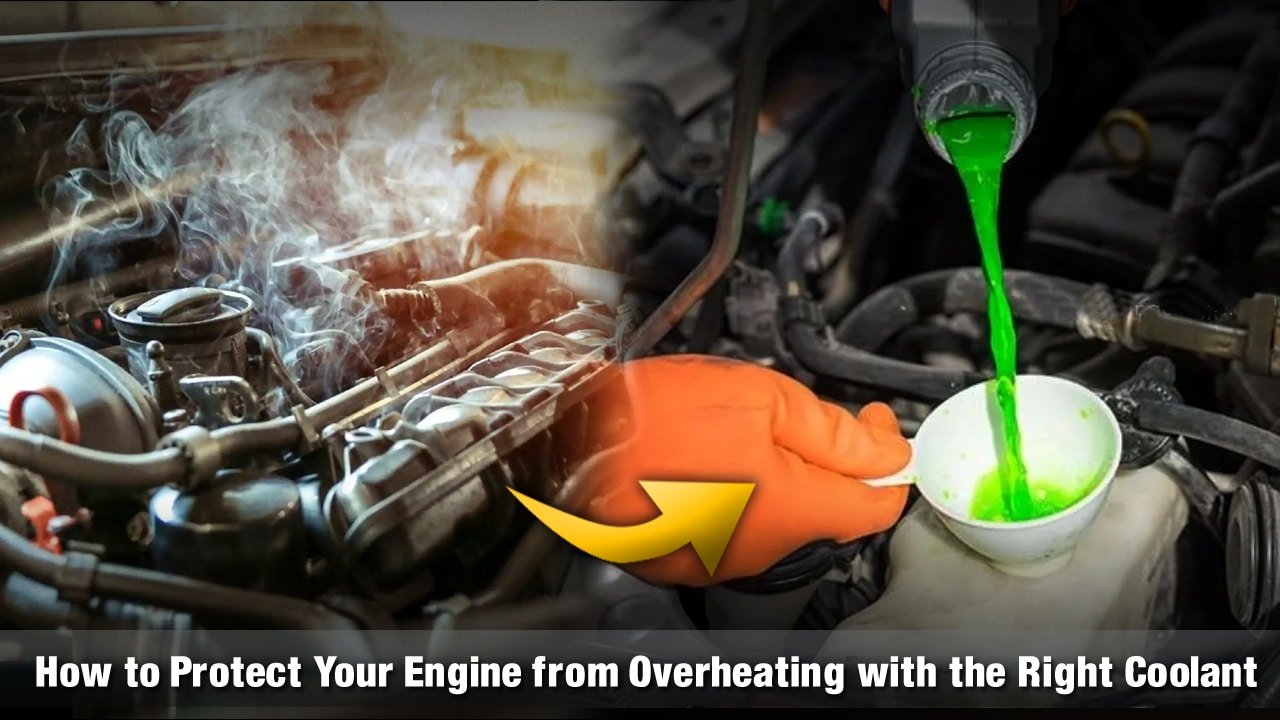
Your engine works hard every time you hit the road—and that hard work generates heat. Without proper protection, this heat can quickly lead to overheating, damaging vital engine parts, and result in costly repairs. That’s where engine coolant steps in. More than just a colored liquid, coolant plays a crucial role in maintaining stable temperatures, preventing corrosion, and ensuring your vehicle runs smoothly.
In this guide, we’ll break down everything you need to know about coolant—why it matters, how to choose the right type, and how to maintain your cooling system for long-term performance and peace of mind.
Understanding Engine Overheating
Every engine is designed to operate within a specific temperature range for peak performance. When the engine overheats and exceeds its safe limit, it can lead to serious issues. Engine overheating can damage critical components, such as the head gasket, pistons, and cylinders, leading to costly repairs or even total engine failure.
What Causes a Car to Overheat?
While hot weather can raise engine temperatures, it’s often not the only cause. Common reasons for engine overheating include:
- Low coolant levels
- Leaks in the cooling system
- A faulty water pump
- A stuck or failing thermostat
If you notice steam from under the hood or see the temperature gauge rising above normal, these are clear warning signs of overheating. In such cases, it’s crucial to stop driving, let the engine cool, and identify the problem immediately.
Why Quick Action Matters
Ignoring engine overheating can le ad to permanent damage. Whether it’s a minor coolant issue or a failing part, always address the cause right away to avoid further complications. Using high-quality lubricants and coolants, like those offered by Fubex Lubricants, can help protect your engine and maintain optimal performance.
How to Handle Engine Overheating While Driving
If your engine starts overheating on the road, staying calm and acting fast can prevent severe damage. Follow these steps:
Turn Off the Air Conditioning
Switch off your A/C immediately to reduce the load on the engine. This small step helps lower the engine temperature and prevents it from working harder than necessary.
Turn On the Heater and Fan to Full Blast
It may sound strange, but cranking up the heater pulls heat away from the engine and pushes it into the car’s cabin. This helps cool the engine down more quickly.
Top Off the Coolant
If available, add coolant or water to the cooling system. This can temporarily lower the temperature enough to get you to a safe spot.
Necessary: Never open the radiator cap while the engine is hot—it can spray boiling coolant and steam. Wait at least 15–30 minutes for the motor to cool, and use a cloth or glove to protect your hand when removing the cap.
Rev the Engine in Neutral or Park
If stuck in traffic, shift to neutral or park and gently rev the engine up to 1500 RPM. This helps move coolant and air through the radiator. Additionally, release your foot from the brake pedal to enhance airflow under the hood.
Pull Over if the Temperature Keeps Rising
If the temperature gauge doesn’t drop, pull over safely and shut off the engine. Open the hood (from inside the car) to let heat escape, but don’t touch the engine until it has cooled for at least 30 minutes. Call for roadside assistance or have your car towed to a mechanic.
How to Choose the Right Antifreeze for Your Engine
When it comes to engine coolants, it’s not just about color—it’s about compatibility. With numerous antifreeze options available, selecting the right one for your vehicle is crucial for maintaining engine health and achieving long-term performance.
Whether you’re topping off your coolant during regular maintenance or doing a complete radiator flush and refill, choosing the wrong antifreeze can lead to serious problems. Mixing incompatible coolants can trigger chemical reactions that cause gelling, blockage, or corrosion inside your engine. This results in reduced cooling efficiency and potential long-term engine damage.
Types of Antifreeze and Their Applications
To make it easier, here’s a quick guide to common types of coolant and where they’re typically used:
IAT (Inorganic Additive Technology)
- Best for: Older vehicles (2001 and earlier)
- Common color: Green
- Note: Needs to be changed more frequently
OAT (Organic Acid Technology)
- Best for: General Motors, Saab, Volkswagen
- Standard colors: Orange, but can also be red, pink, dark green, yellow, or purple
- Note: Longer life, not suitable for all engines
HOAT (Hybrid Organic Acid Technology)
- Best for: Ford, Chrysler, and many European brands
- Common color: Yellow
- Note: Combines benefits of IAT and OAT
Phosphate-Free HOAT
- Best for: BMW, Volvo, Tesla, MINI
- Common color: Turquoise
- Note: Avoids phosphate deposits in European engines.
Phosphated HOAT
- Best for: Toyota, Honda, Nissan, Hyundai, Kia, Mazda
- Standard colors: Pink or blue
- Note: Specifically designed for Asian vehicles
Silicated HOAT
- Best for: High-performance European cars (Mercedes-Benz, Audi, Porsche, some VW models)
- Common color: Purple
- Note: Designed to protect aluminum components
Don’t Rely on Color Alone
While color can give a general idea, it’s not a reliable way to choose coolant. Always check your owner’s manual or consult a trusted mechanic to ensure you’re using the correct type of antifreeze for your specific make and model.
Using the proper coolant, along with premium-quality lubricants helps keep your engine running cooler, longer, and with fewer issues.
Understanding the Coolant System in Your Vehicle
The coolant system plays a crucial role in maintaining the safe operating temperature of your engine. Its main job is to transfer excess heat away from the engine, preventing overheating and maintaining optimal performance. This system relies on a group of key components—each working together to ensure efficient cooling during every drive.
Key Components of the Coolant System
Radiator
The radiator is the heart of the cooling system. It removes heat from the coolant by allowing outside air to flow through its fins. This cooling process is vital, especially under heavy loads or prolonged driving, to maintain engine temperatures within safe limits.
Water Pump
The water pump keeps the coolant moving through the engine and radiator. Powered by a belt, it ensures continuous circulation. If the water pump fails, coolant flow slows down—leading to engine overheating.
Thermostat
The thermostat acts like a temperature-sensitive valve. When the engine is cold, it stays closed to help the engine warm up quickly. Once the ideal temperature is reached, it opens to let coolant flow and maintain consistent heat levels.
Heater Core
Located inside the cabin, the heater core uses hot coolant to produce warm air for the interior. It works similarly to the radiator and also plays a role in overall cooling. Leaks or blockages in the heater core can disrupt system efficiency.
Fan Clutch
The fan clutch controls when the engine fan turns on or off. It engages when the engine requires extra cooling, such as during idling or low-speed driving. A working fan clutch ensures proper airflow through the radiator when it’s needed most.
By maintaining your truck’s coolant system in good condition and using high-quality coolants and additives, you can protect your engine from heat damage, reduce wear, and enhance long-term reliability.
How Often Should You Change Your Engine Coolant?
Replacing your engine coolant is a crucial part of routine maintenance—and skipping this step can lead to overheating, corrosion, and costly repairs. But how often should it be done?
General Coolant Replacement Guidelines
In most vehicles, engine coolant should be replaced every 100,000 miles or every 5 years, whichever comes first. Some extended-life coolants claim to last up to 160,000 miles, but it’s always safest to follow the manufacturer’s recommended service interval listed in your owner’s manual.
Factors That May Require More Frequent Changes
If you often drive in:
- Hot climates
- Stop-and-go traffic
- Towing or heavy loads
- Mountainous or dusty terrain
Your cooling system works harder—and your coolant may need to be replaced more often to prevent engine strain or damage.
Signs Your Coolant Needs Changing
Keep an eye out for these signs that your coolant may need attention:
- Coolant appears dirty or rusty.
- Low coolant levels without explanation.
- A sweet, syrup-like smell under the hood (could indicate a leak).
- The engine temperature gauge is running hotter than usual.
In these cases, a coolant flush and refill should be done promptly—even if you haven’t reached the mileage interval yet.
Why Coolant Maintenance Matters
Regular coolant replacement helps:
- Prevent engine overheating.
- Stop corrosion inside the radiator and engine.
- Maintain cooling system performance.
- Extend the lifespan of your engine.
It’s a simple, affordable service that protects your car from severe—and expensive—damage.
At Fubex Lubricants, we recommend pairing the correct coolant type with high-quality engine oils to get the best protection and performance from your vehicle. Always use products designed for your specific make and model to avoid compatibility issues.
Also Read: How Does Diesel Engine Oil Protect Against Engine Overheating?
Smart Tips for Choosing the Right Coolant for Your Vehicle
Picking the correct coolant isn’t just about keeping your engine cool—it’s about long-term protection and performance. Here’s how to make the best choice:
- Follow Your Owner’s Manual: Your vehicle’s manual is your best guide. It specifies the exact type of coolant recommended for your engine and cooling system.
- Don’t Mix Coolant Types: Mixing different coolants can trigger chemical reactions that reduce performance and may even harm your engine. Stick to one compatible type.
- Check Compatibility: Not all coolants are the same. Some need to be diluted with water, while others are pre-mixed and ready to use. Always check the label for details.
- Ignore the Color: The coolant color (green, orange, pink, etc.) isn’t a reliable indicator for selection. Instead, look for manufacturer-approved formulas that match your vehicle’s specs.
- Stay on Top of Maintenance: Regularly inspect your coolant level and condition to ensure optimal performance. Flush and replace it according to your manufacturer’s schedule to avoid overheating, corrosion, and engine damage.
Using the right coolant—alongside premium lubricants ensures your engine stays protected in every season and on every road.
Final Takeaways
Overheating can turn a smooth ride into a roadside emergency—but with the proper coolant and regular maintenance, you can keep your engine running at its best. From choosing the correct antifreeze to spotting early warning signs, a little attention goes a long way in protecting your vehicle.
At Fubex Lubricants, we’re here to help you make wise choices with high-quality coolants and engine oils designed for lasting performance. Stay ahead of breakdowns—check your coolant, follow your service schedule, and drive with confidence.
FAQs
Q1: Is it safe to mix different types of engine coolant?
Mixing different types of engine coolant is not recommended unless it’s a universal formula approved for your vehicle. Always check compatibility to avoid damaging your cooling system.
Q2: Can I use water as a substitute for engine coolant?
No, water alone doesn’t provide proper protection. Always use a 50/50 mix of water and antifreeze to guard against overheating, corrosion, and freezing.
Q3: When should I replace my engine coolant?
Follow your car manufacturer’s recommended interval, but also replace it sooner if the coolant looks dirty, discolored, or tests as overly acidic.

Editor-at-Large
A passionate writer in the lubricant industry, Awais Iqbal has been covering oils, greases, and industrial fluids since the start of his career. At 25, he’s already written for blogs, catalogs, and brand guides across the UAE. Awais’s insights help companies connect with their audience, and his clear, helpful writing style is trusted by brands in the region.


